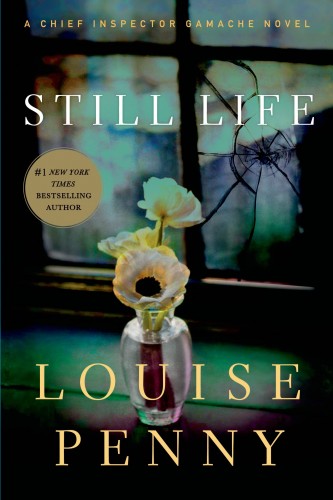Glass Houses is the latest entry in Louise Penny’s long-running mystery series featuring Armand Gamache, former head of homicide of the Sûreté de Québec. Gamache and his wife Reine-Marie live in the village of Three Pines, a place so tiny it doesn’t appear on any maps. For long-time readers of the series, the inhabitants of Three Pines have become like old friends. They include Clara the artist, Myrna the bookstore owner, Olivier and Gabri, the owners of the bistro and bed and breakfast, and the cantankerous old poet Ruth, who has a pet duck named Rosa. Gamache has come out of retirement to become the Chief Superintendent, the head of the whole Sûreté. But he faces charges of incompetence from politicians and the media, who accuse him of not making enough arrests and letting the drug trade run rampant.
The book begins during Three Pines’ Halloween party when a mysterious figure in a black cloak and mask appears on the village green. At first the villagers think it’s a man in a Halloween costume, but it stays for two days in a row, in the freezing cold and sleet. Gamache soon learns that the figure is tied to an old Spanish legend of the cobrador del frac. In modern times, the cobrador del frac wears a top hat and tails and follows people around to shame them into paying their debts. But there’s a much older legend going back to the Middle Ages, when plague victims and witches were sent to an island, and the survivors came back in black cloaks to haunt the people who exiled them. For the original cobradors, the debt they collected was moral, not financial. It is such a figure, Gamache realizes, that has come to Three Pines. The cobrador represents the conscience of its victim. But who has it come for? All the inhabitants, including Gamache, have done things they’re not proud of. Could the cobrador have come for one of them, or for one of the visitors to Three Pines, four friends from university who are celebrating their reunion? Or could it be haunting one of the two new inhabitants, a dishwasher at the bistro and a baker’s assistant? Then the cobrador suddenly disappears, and Reine-Marie finds the body of one of the visitors, Katie Evans, an architect who builds glass houses, in the church basement. Katie has been dressed in the cobrador’s cloak. Gamache doubts that Katie was the one the cobrador came to haunt, since cobradors did not kill their victims. But who killed her, and what happened to the cobrador?
Unusually for Penny, Glass Houses is not a straight narrative. Rather, it alternates between these events and the trial, months later in the sweltering heat of July, of the person accused of murdering Katie. You do not learn the person’s identity until the end. Gamache is the chief witness for the prosecution, but he and the Crown Prosecutor are obviously hostile to each other. The judge suspects they are playing a game and that something much larger than one person’s trial is really going on. But what can it be?
Besides the drama of the murder and the trial, there is the story of Gamache’s efforts to stop the drug trade in Québec by catching the head of Canada’s largest drug cartel in the act of smuggling drugs into the United States. Gradually the reader learns there is a connection between the murder and the drug trade, but part of the suspense is figuring out what it is. The novel keeps you on the edge of your seat. As usual with Penny, it’s more than just a whodunit, as it explores larger moral issues. In this case, it is the nature of conscience, and how people’s actions in the past come back to haunt them. Penny uses the plague as an effective metaphor, as she describes the drug trade as a modern-day plague. Glass Houses is impossible to put down, and you will fall in love with Three Pines if you haven’t already. But readers new to the series should start with the first book, Still Life.
Glass Houses can be borrowed from the Recreational Reading Collection at the Art, Architecture and Engineering Library or the Browsing Collection of the Shapiro Undergraduate Library.
Still Life is available from the Hatcher Graduate Library.
